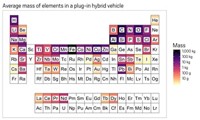Advertisement
Grab your lab coat. Let's get started
Welcome!
Welcome!
Create an account below to get 6 C&EN articles per month, receive newsletters and more - all free.
It seems this is your first time logging in online. Please enter the following information to continue.
As an ACS member you automatically get access to this site. All we need is few more details to create your reading experience.
Not you? Sign in with a different account.
Not you? Sign in with a different account.
ERROR 1
ERROR 1
ERROR 2
ERROR 2
ERROR 2
ERROR 2
ERROR 2
Password and Confirm password must match.
If you have an ACS member number, please enter it here so we can link this account to your membership. (optional)
ERROR 2
ACS values your privacy. By submitting your information, you are gaining access to C&EN and subscribing to our weekly newsletter. We use the information you provide to make your reading experience better, and we will never sell your data to third party members.
Environment
Measuring The Electric Vehicle's Environmental Footprint
Transportation: Life-cycle analysis shows that lithium-ion batteries are not the environmental concern experts once imagined
by Naomi Lubick
August 13, 2010

Electric vehicles have more than technical hurdles to overcome: Some experts fear that the vehicles' environmental impact is no lighter than that of gas-powered vehicles. And the biggest concerns center on the vehicles' all-important batteries.
Now researchers have published the first in-depth environmental analysis of electric cars using lithium-ion batteries, and have found that they beat their gas-fueled counterparts (Environ. Sci. Technol., DOI: 10.1021/es903729a).
When experts consider batteries' environmental footprint, they worry about a range of issues, including the impacts of mining the necessary metals, the chemical manufacturing process, and whether the batteries end up in landfills or get recycled.
To break down all the possible environmental impacts, Dominic Notter of the Swiss Federal Laboratories for Materials Science and Technology, and colleagues performed a detailed life-cycle analysis of lithium-ion batteries—a fast-growing battery class—and included it in an assessment of electric vehicles' environmental impact. In their battery calculations, they accounted for the consequences of each stage of a battery's life from the impacts of lithium mining to the global warming potential of emissions from electricity production.
According to the researchers' analysis, about 15% of an electric vehicles' total environmental burden comes from manufacturing, maintaining, and disposing of the lithium-ion battery. Most of those costs, about 50%, stem from mining and manufacturing the copper and aluminum used in the battery and its connecting cables. Extracting the necessary lithium produces only 2.3% of the battery's total environmental footprint.
And while they did not calculate the impacts of end-of-life issues for lithium batteries directly, prior work suggests that recycling can cut down on such costs. "The lithium-ion battery is not as bad as it is assumed to be," Notter says.
Still, the largest contributor to electric vehicles' total environmental burden comes from recharging the battery. These operational costs were three times greater than the battery alone, but they fluctuated when the researchers looked at other electricity sources besides the typical European power mixture that includes nuclear power, hydropower, and fossil fuels. When the vehicles charged up on electricity from coal-fired plants alone, their total environmental impact increased by 13%, but it dropped by 40% when the electricity came solely from hydropower.
Overall, when the researchers compared battery-powered vehicles to their gas-fueled counterparts, they calculated that a car with an internal combustion engine would need a fuel economy of about 60 to 80 mpg to achieve a lower environmental impact than a battery-powered electric vehicle that recharged using European power sources.
The study confirms that lithium-ion batteries themselves are "a small part of the environmental impact of a plug-in electric vehicle, whether battery or hybrid," says Eladio Knipping, a researcher at the Electric Power Research Institute, a nonprofit industry research group in Palo Alto, Calif. And Constantine Samaras of the RAND Corporation in Pittsburgh, Pennsylvania, hopes that the researchers' detailed accounting of the environmental impacts of each lithium-ion battery component will help engineers identify parts that could be more environmentally friendly.




Join the conversation
Contact the reporter
Submit a Letter to the Editor for publication
Engage with us on Twitter